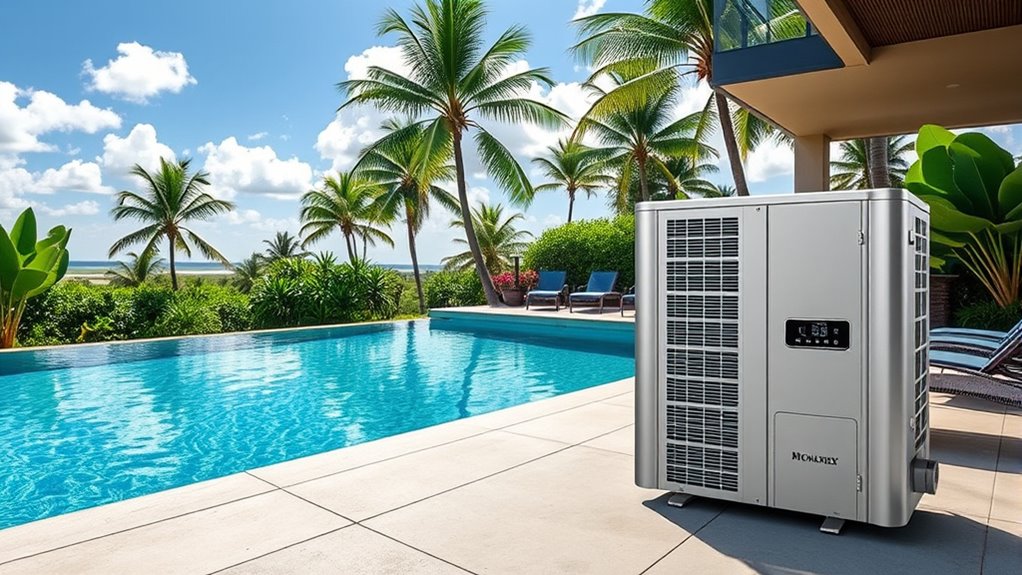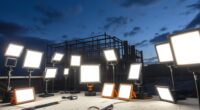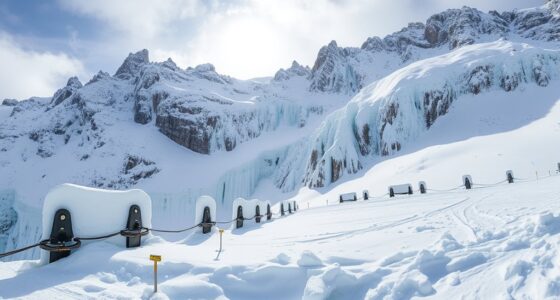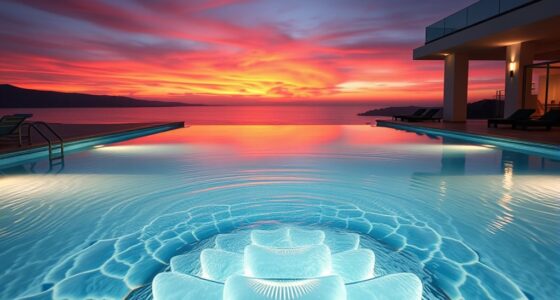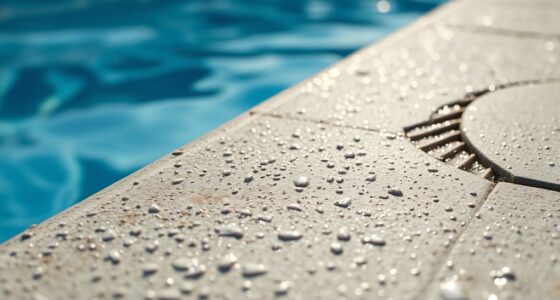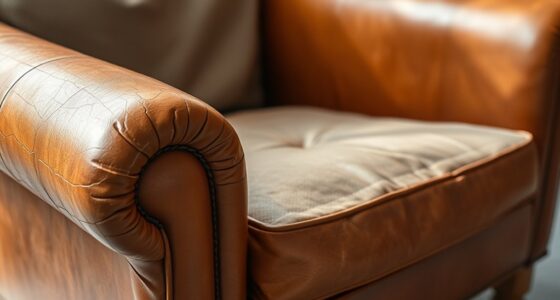Choosing the right heat pump size is essential for your vanishing-edge pool’s performance. An undersized unit struggles to keep the water warm, especially during colder months, leading to longer run times and higher energy bills. Conversely, a too-large system wastes energy and wears out faster. To avoid these issues, make certain of proper sizing based on your pool’s size, climate, and usage. Keep going to discover how to get it just right.
Key Takeaways
- Properly size the heat pump based on pool volume, shape, and environmental factors to prevent undersizing and ensure efficient heating.
- Consult with a professional to perform detailed load calculations tailored to vanishing-edge pools’ unique features.
- Avoid selecting units solely on initial cost; prioritize capacity that meets cold-weather demands for consistent temperatures.
- Consider climate, exposure, and usage patterns to determine the correct capacity, preventing short cycling and energy waste.
- Proper sizing extends equipment lifespan, improves performance, and maintains comfortable, stable pool temperatures year-round.
Understanding Heat Pump Sizing and Its Impact on Your Pool
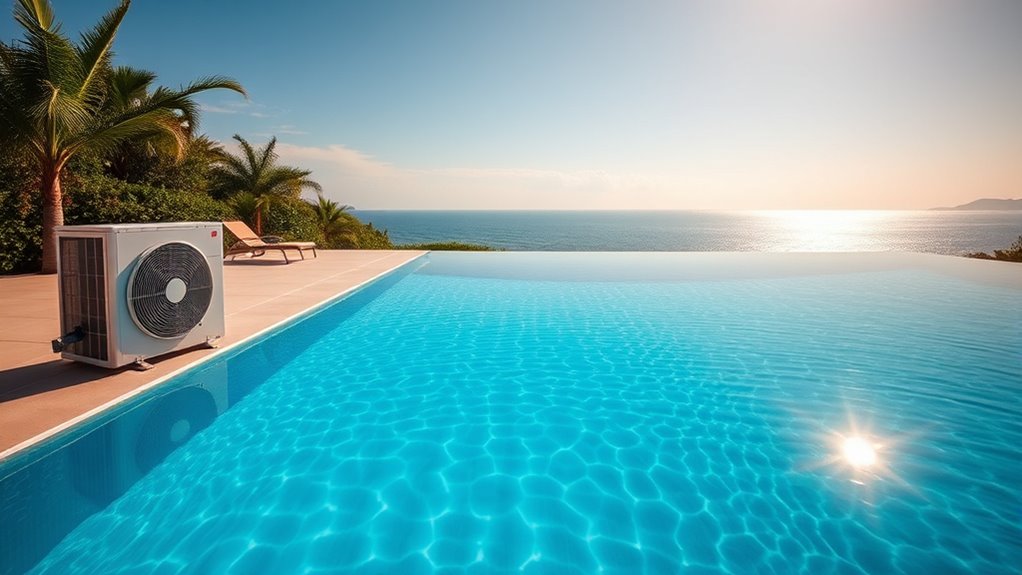
Understanding how to size a heat pump correctly is essential because it directly affects your pool’s heating efficiency and energy costs. If you choose a unit that’s too small, it’ll struggle to maintain your desired temperature, especially during colder months, leading to longer run times and higher energy bills. Conversely, an oversized heat pump may cycle on and off frequently, wasting energy and causing unnecessary wear. Proper sizing guarantees your pool heats quickly without unnecessary energy consumption or equipment strain. To determine the right size, consider your pool’s surface area, volume, and local climate conditions. Accurate sizing maximizes efficiency, reduces operating costs, and extends your heat pump’s lifespan—making your investment worthwhile.
Why Undersizing Can Lead to Pool Heating Failures
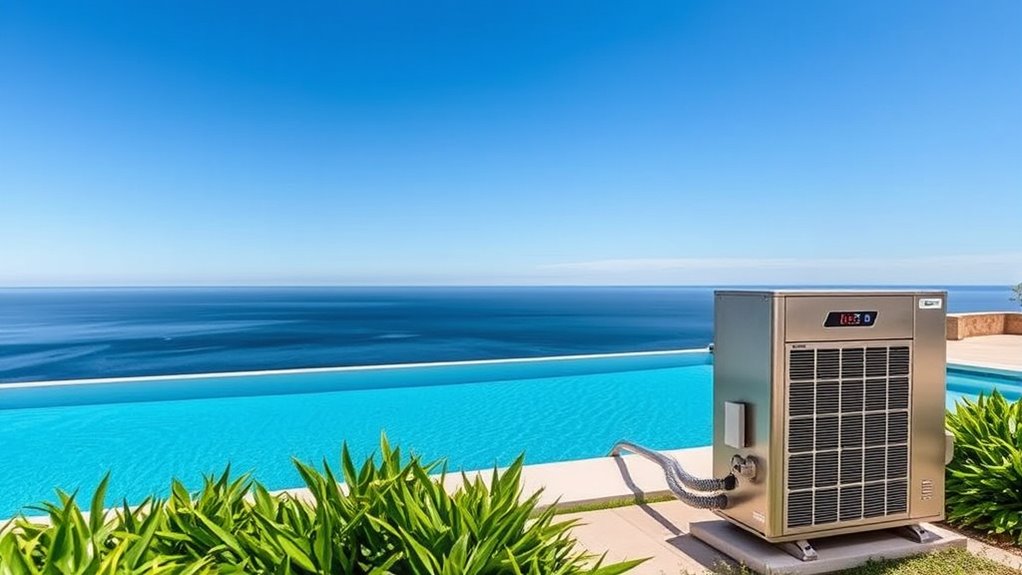
When your heat pump is undersized, it simply can’t keep up with your pool’s heating demands, especially during colder weather. This means the pump runs more frequently and longer, increasing wear and tear and energy costs without reaching your desired temperature. Persistent underperformance leads to frustration and temperature swings, making your pool uncomfortable and unusable when you want it most. An undersized unit struggles to offset heat loss from evaporation, radiation, and pool circulation, causing the pool to stay cold or take too long to warm up. Over time, this can damage the heat pump and reduce its lifespan. Ultimately, undersizing results in ineffective heating, higher expenses, and a less enjoyable pool experience. Proper sizing ensures reliable, efficient heating that keeps your vanishing-edge pool comfortable year-round.
Factors to Consider When Determining the Right Size for Your Vanishing-Edge Pool
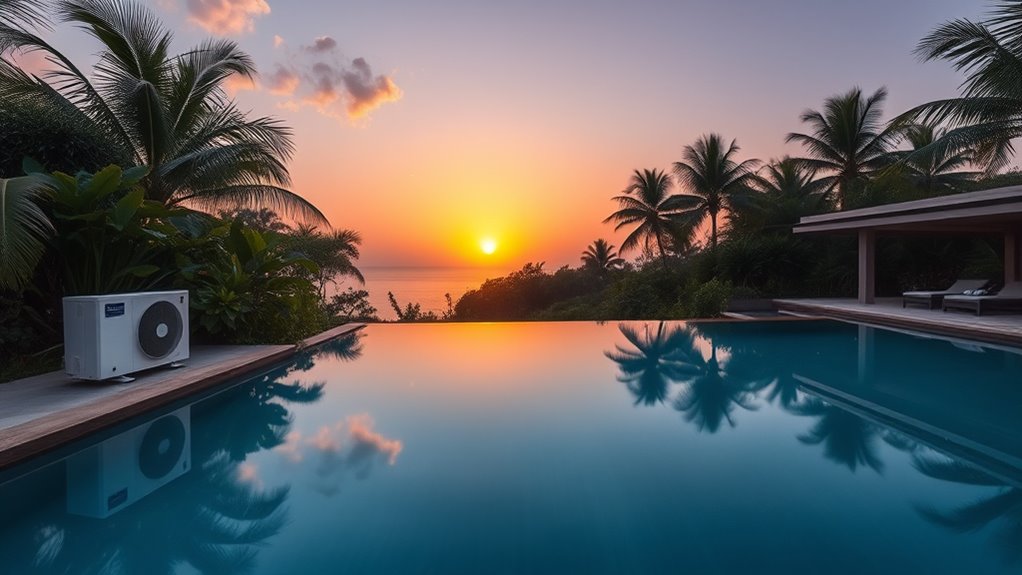
When choosing the right heat pump size for your vanishing-edge pool, you need to consider its size and volume, as larger pools require more heating power. Your climate and typical temperature range also play an essential role in determining the necessary capacity. Additionally, how often and how long you use your pool influences the size needed to maintain comfortable temperatures efficiently. Consulting total‑cost clarity and energy efficiency factors can help you make an informed decision that balances performance and expenses.
Pool Size and Volume
Choosing the right size for your vanishing-edge pool starts with evaluating its volume, which directly influences the heating needs and overall efficiency of your heat pump. Larger pools hold more water, requiring more heat to maintain desired temperatures, so an undersized heat pump struggles to keep up. Conversely, an oversized unit may cycle on and off frequently, wasting energy and increasing wear. To determine the appropriate size, calculate your pool’s total water volume in gallons or liters. Consider the shape and depth variations, as these affect volume calculations. Knowing your pool’s size helps you select a heat pump that provides consistent heating without excessive energy use. Proper sizing guarantees efficient operation, cost savings, and a comfortable swimming environment. Additionally, understanding the impact of cookies and how they influence website performance can help you access detailed guides and tools for accurate pool sizing.
Climate and Temperature Range
Climate and temperature range are critical factors that influence the size of your heat pump for a vanishing-edge pool. In colder climates, you’ll need a larger, more powerful heat pump to maintain comfortable water temperatures. Conversely, milder climates require less capacity, saving energy and costs. Consider the typical seasonal lows and highs in your area to determine the necessary heating capacity. Proper sizing also involves understanding Kia Tuning options that can optimize system performance and efficiency.
Usage Frequency and Patterns
The frequency and patterns of your pool’s usage directly impact the size of the heat pump you need. If you use your vanishing-edge pool daily or for extended periods, you’ll want a larger unit to maintain consistent temperatures without strain. Conversely, if you only swim occasionally or during certain seasons, a smaller heat pump may suffice, saving energy and costs. Consider these factors:
- How often you swim or use the pool each week
- The typical duration of each session
- Whether multiple users will be in the pool simultaneously
Calculating the Correct Heat Pump Capacity for Your Pool Size and Climate
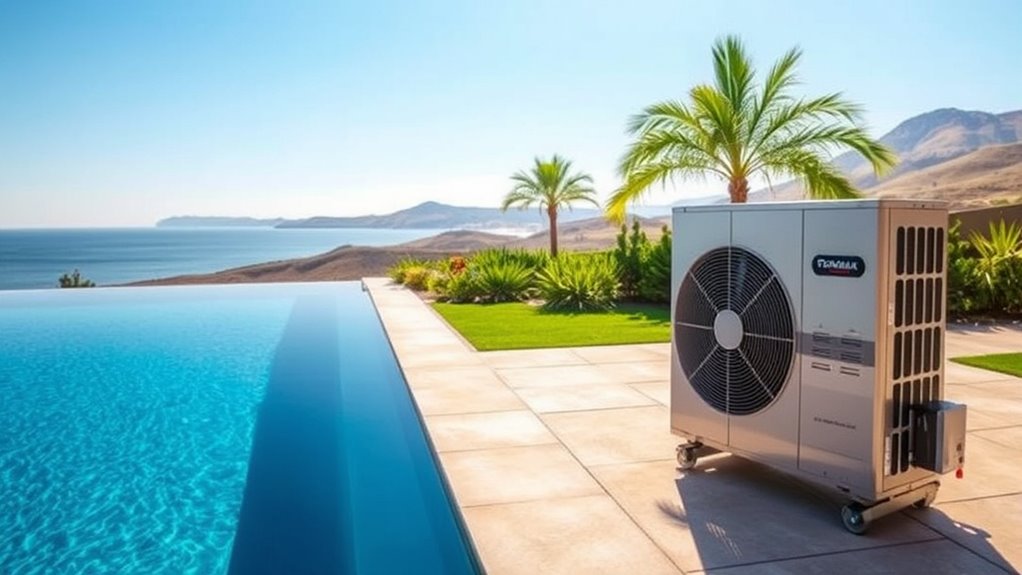
To choose the right heat pump capacity, you need to take into account your pool’s size and your local climate. Factors like pool volume, exposure to sunlight, and average temperatures directly affect the necessary capacity. By understanding these influences, you can guarantee your pool heats efficiently and maintains consistent comfort. Additionally, considering the design of your pool area, such as surrounding landscape and shading, can further optimize heating performance.
Factors Influencing Capacity
Choosing the right heat pump capacity depends on several key factors that directly affect its efficiency and effectiveness. Your pool’s size isn’t the only consideration; other elements influence the needed capacity. These include:
- Pool exposure to sunlight: More sun exposure means less heating needed.
- Pool usage frequency: More frequent use requires a higher capacity to maintain temperature.
- Desired water temperature: The higher your target temperature, the greater the heating load.
- Potential benefits of eye patches for soothing and hydrating delicate skin around the eyes, which can be an important aspect of overall comfort and self-care routines that complement your pool maintenance and leisure activities.
Climate’s Impact on Sizing
Climate plays a crucial role in determining the appropriate heat pump size for your vanishing-edge pool. In colder environments, you’ll need a larger capacity heat pump to compensate for increased heat loss. Conversely, in warmer climates, a smaller unit often suffices, as less energy is required to maintain your desired temperature. Humidity levels also influence efficiency, with high humidity reducing heat transfer and demanding a more powerful system. When sizing your heat pump, consider seasonal temperature fluctuations and local weather patterns. Properly matching your heat pump to your climate ensures consistent comfort and ideal performance. Additionally, understanding projector technology can help you optimize your pool area for both aesthetics and functionality.
Common Mistakes Pool Owners Make When Selecting Heat Pumps
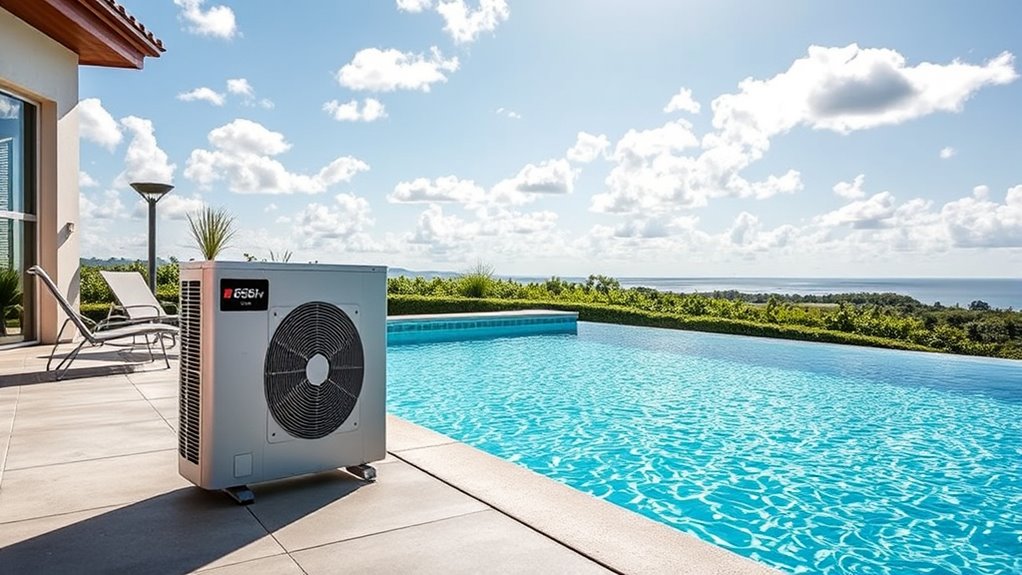
Many pool owners make the mistake of selecting a heat pump based solely on its cost or basic specifications, without considering their specific pool size and usage needs. This approach often leads to undersized units that struggle to heat the pool efficiently or oversized units that waste energy and increase costs. To avoid this, you should consider the following common mistakes:
Choosing a heat pump without considering pool size can lead to inefficiency and higher costs.
- Ignoring the pool’s actual size and volume, leading to improper sizing
- Overlooking local climate factors that impact heating demands
- Choosing a heat pump based only on initial price, neglecting long-term energy costs
- Failing to account for cold-pressed vegetable juice benefits, which can influence energy efficiency and heating performance.
Benefits of Properly Sized Heat Pumps for Energy Efficiency and Longevity

When a heat pump is properly sized for your vanishing-edge pool, it operates more efficiently and lasts longer. You’ll notice lower energy bills because the system doesn’t need to work as hard to maintain your desired temperature. Proper sizing reduces strain on the compressor and other components, decreasing wear and tear, which extends the lifespan of your heat pump. An appropriately sized unit responds quickly to temperature changes without cycling excessively, ensuring consistent comfort. This efficiency also minimizes energy waste, making your pool heating more environmentally friendly. Over time, the durability and reliability of a well-sized heat pump save you money on repairs and replacements. Understanding cotton candy variations can help you appreciate the importance of selecting the right size for optimal performance. In short, correct sizing helps you enjoy a comfortable, cost-effective, and long-lasting pool heating solution.
Tips for Consulting Professionals and Ensuring Accurate Sizing
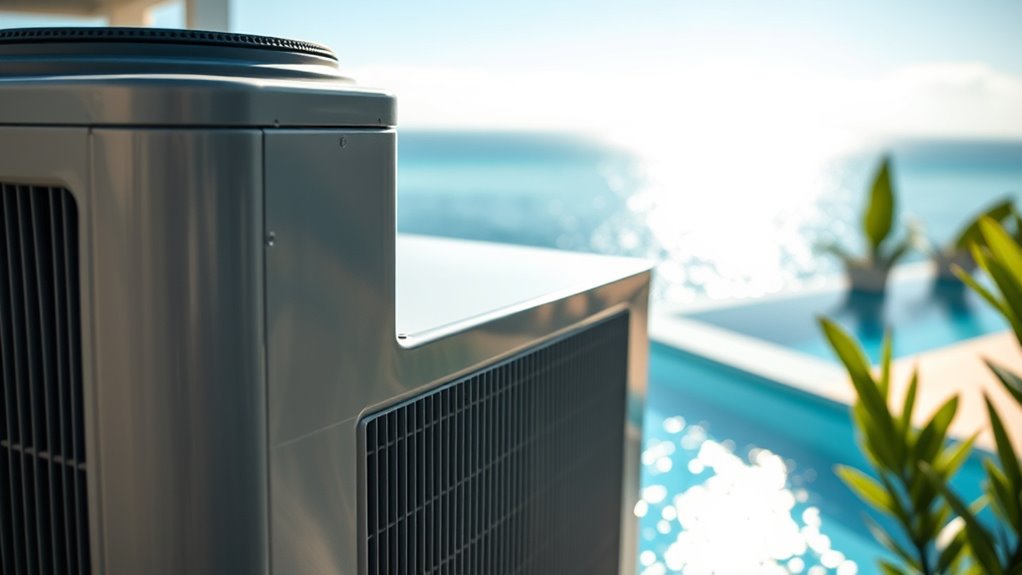
Consulting with experienced professionals is essential to guarantee your vanishing-edge pool’s heat pump is accurately sized. They bring expertise in evaluating your pool’s specific needs, climate conditions, and system design. To ensure precise sizing, consider these tips:
Expert consultation ensures your vanishing-edge pool’s heat pump is perfectly sized for optimal performance.
- Clearly communicate your pool’s size, usage patterns, and desired operating temperature.
- Request a detailed load calculation that accounts for environmental factors and pool features.
- Choose qualified contractors familiar with vanishing-edge pools and energy-efficient equipment.
- Be aware that proper heat pump sizing can significantly improve energy efficiency and prolong equipment lifespan.
Frequently Asked Questions
How Often Should I Have My Heat Pump System Inspected?
You should have your heat pump system inspected at least once a year to guarantee peak performance and longevity. Regular inspections help catch potential issues early, saving you money on repairs and maintaining efficiency. If you use your pool frequently or experience harsh weather, consider more frequent check-ups. Schedule professional inspections before peak season, typically in spring, to prepare your system for the upcoming use.
What Maintenance Is Required to Keep My Heat Pump Efficient?
Did you know regular maintenance can boost your heat pump’s efficiency by up to 25%? To keep it running smoothly, clean or replace filters monthly, check the coils for dirt or debris, and make certain the airflow isn’t obstructed. Schedule an annual professional inspection to catch issues early. Keep the area around the unit clear, and monitor for strange noises or leaks, so your system stays energy-efficient and lasts longer.
Can I Upgrade My Existing Heat Pump to a Larger Size Later?
Yes, you can upgrade your existing heat pump to a larger size later. Start by consulting a professional to assess your current system and determine the appropriate size increase. They’ll evaluate your pool’s heating needs, existing electrical capacity, and compatibility. Upgrading guarantees efficient heating as your pool size or usage changes, but proper sizing and installation are vital to avoid inefficiencies and unnecessary costs.
How Does Outdoor Temperature Fluctuation Affect Heat Pump Performance?
Outdoor temperature fluctuations can considerably impact your heat pump’s performance. When temperatures drop, your heat pump works harder to maintain your pool’s temperature, which can lead to increased energy use and wear. Conversely, warmer weather makes it easier for your system to operate efficiently. To guarantee consistent heating, you might consider a unit designed for colder climates or adding a backup heater for extreme temperature changes.
Are There Specific Brands Recommended for Vanishing-Edge Pool Heat Pumps?
Think of choosing a heat pump brand like picking a reliable car for a long road trip—you want durability and performance. For vanishing-edge pools, brands like Hayward, Pentair, and Jandy come highly recommended for their efficiency and durability. I once installed a Jandy unit that kept my pool warm even during a chilly week, proving their reliability. Stick to these trusted names, and you’ll enjoy a seamless, warm swimming experience.
Conclusion
Getting your heat pump size just right is essential—you don’t want to be caught with your pants down when the weather turns chilly. Proper sizing ensures your vanishing-edge pool stays perfectly heated and saves you money on energy bills. Don’t cut corners or guess blindly; consult professionals and do the math. Remember, a well-sized heat pump is the backbone of a luxurious, trouble-free pool experience—strike while the iron’s hot!
